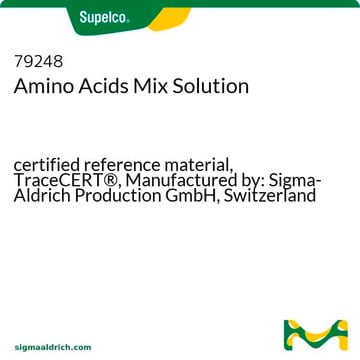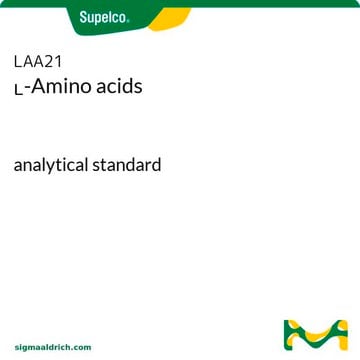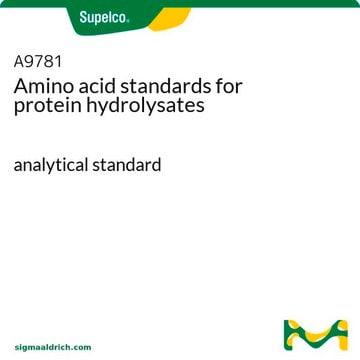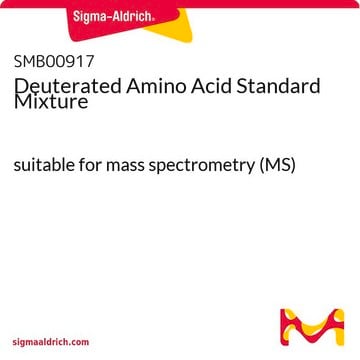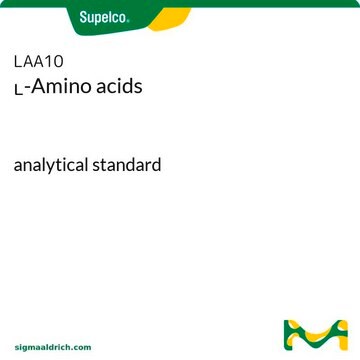Recommended Products
grade
analytical standard
shelf life
limited shelf life, expiry date on the label
analyte chemical class(es)
amino acids, peptides, proteins
technique(s)
HPLC: suitable
gas chromatography (GC): suitable
application(s)
food and beverages
format
multi-component solution
storage temp.
2-8°C
Related Categories
Application
- Determination of L- and D-amino acids and glycine by liquid chromatography-tandem mass spectrometry (LC-MS/MS) following their derivatization with chiral Marfey’s reagent
- High-performance liquid chromatography (HPLC) based amino acid analysis during the characterization of defatted rice bran (DRB) protein concentrate to evaluate its iron binding ability
- Development of a gas chromatography-mass spectrometry (GC-MS) procedure for the profiling of 112 amino-carboxylic metabolites in human urine samples using 1,1,1,2,2,3,3-heptafluorobutyl chloroformate for derivatization and liquid-liquid microextraction for sample treatment
- Non-enantiomeric detection and quantification of amino acids in their various forms— free, dissolved, particulate, and total, in natural water samples by HPLC coupled with fluorescence detection using a C18 column
Packaging
Components
- L-Alanine
- Ammonium chloride
- L-Arginine
- L-Aspartic acid
- L-Cystine
- L-Glutamic acid
- Glycine
- L-Histidine
- L-Isoleucine
- L-Leucine
- L-Lysine
- L-Methionine
- L-Phenylalanine
- L-Proline
- L-Serine
- L-Threonine
- L-Tyrosine
- L-Valine
Other Notes
related product
Signal Word
Warning
Hazard Statements
Precautionary Statements
Hazard Classifications
Met. Corr. 1
Storage Class Code
8B - Non-combustible corrosive hazardous materials
WGK
nwg
Flash Point(F)
Not applicable
Flash Point(C)
Not applicable
Regulatory Listings
Regulatory Listings are mainly provided for chemical products. Only limited information can be provided here for non-chemical products. No entry means none of the components are listed. It is the user’s obligation to ensure the safe and legal use of the product.
ISHL Indicated Name
Substances Subject to be Indicated Names
ISHL Notified Names
Substances Subject to be Notified Names
JAN Code
AAS18-10X1ML:4548174009260
AAS18-VAR:
80994:
AAS18-5X5ML:4548174009284
AAS18-10ML:4548174009253
AAS18-5ML:4548174009277
AAS18-BULK:
AAS18-1ML:
Choose from one of the most recent versions:
Certificates of Analysis (COA)
Don't see the Right Version?
If you require a particular version, you can look up a specific certificate by the Lot or Batch number.
Already Own This Product?
Find documentation for the products that you have recently purchased in the Document Library.
Our team of scientists has experience in all areas of research including Life Science, Material Science, Chemical Synthesis, Chromatography, Analytical and many others.
Contact Technical Service